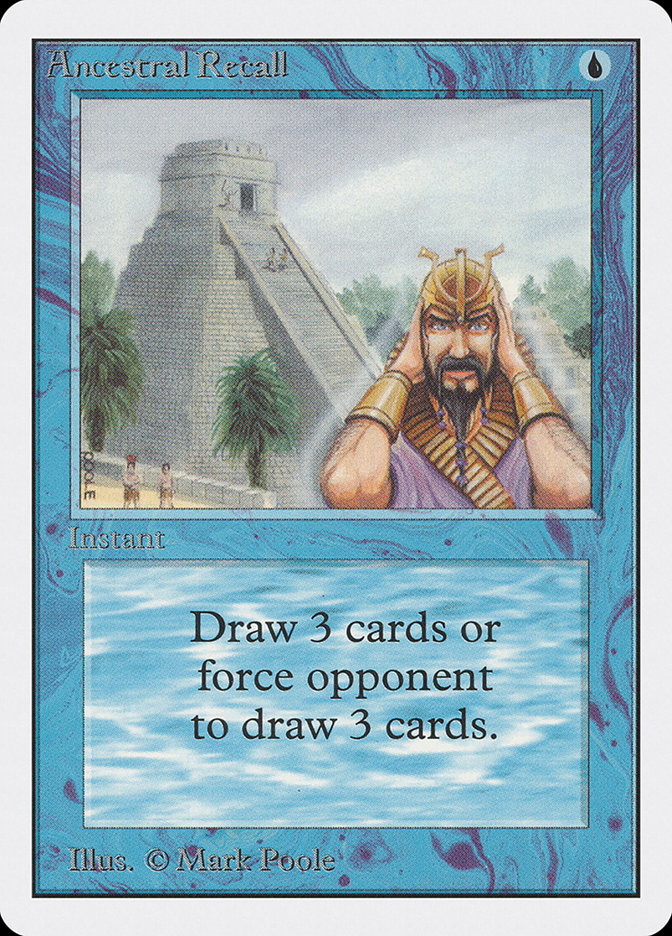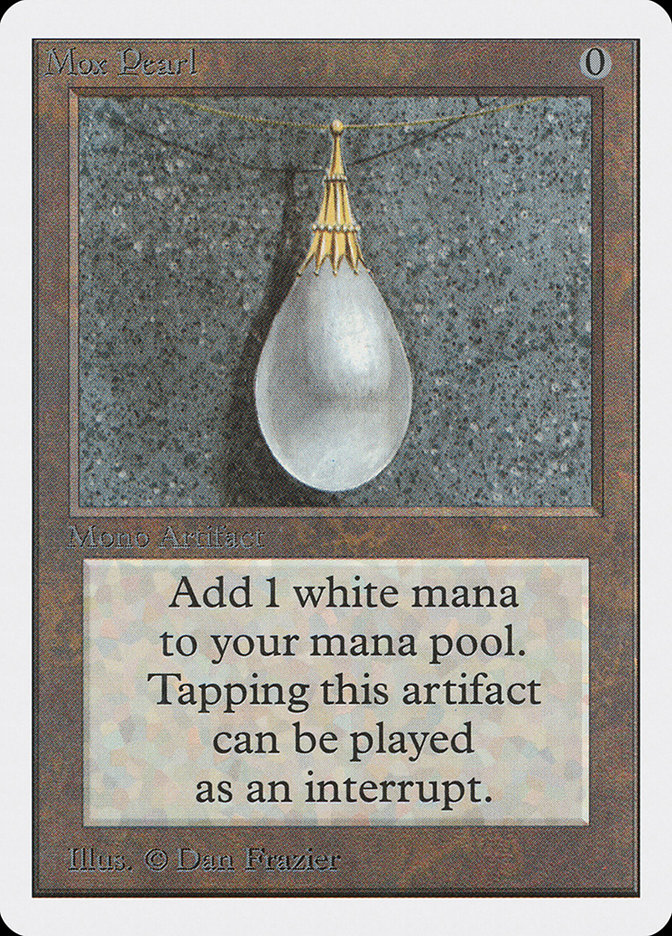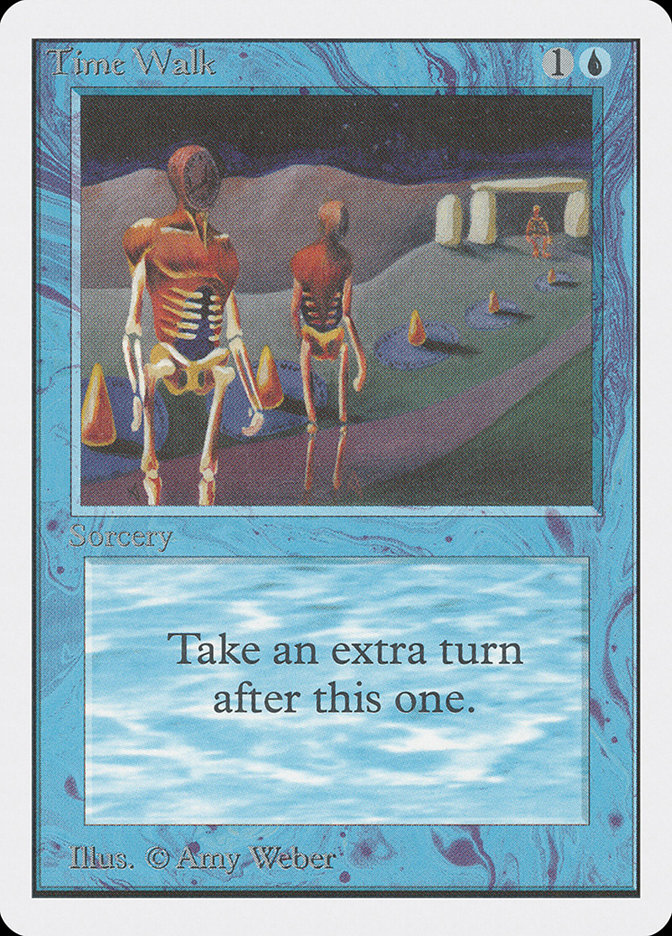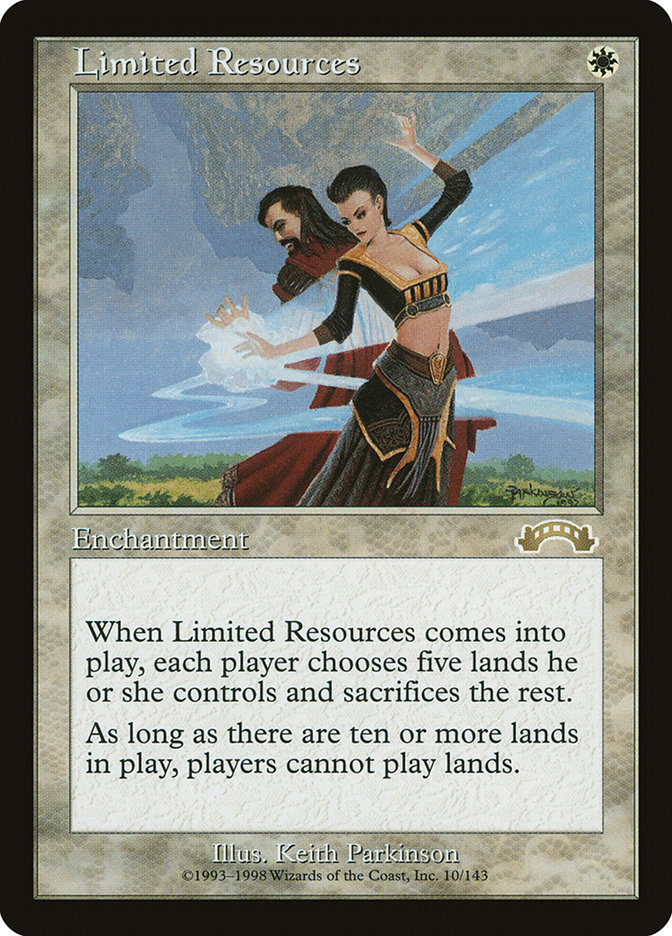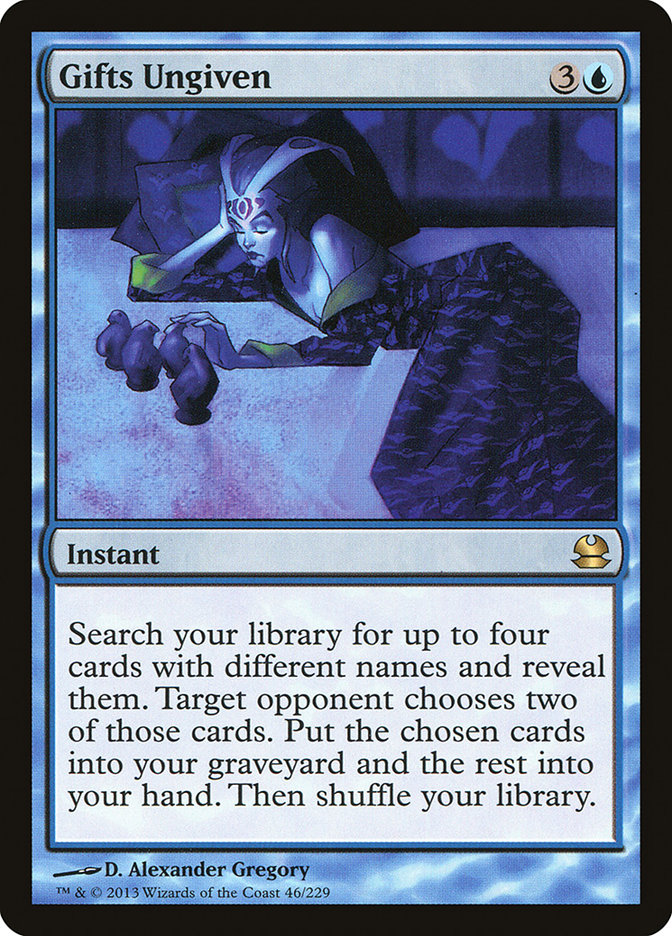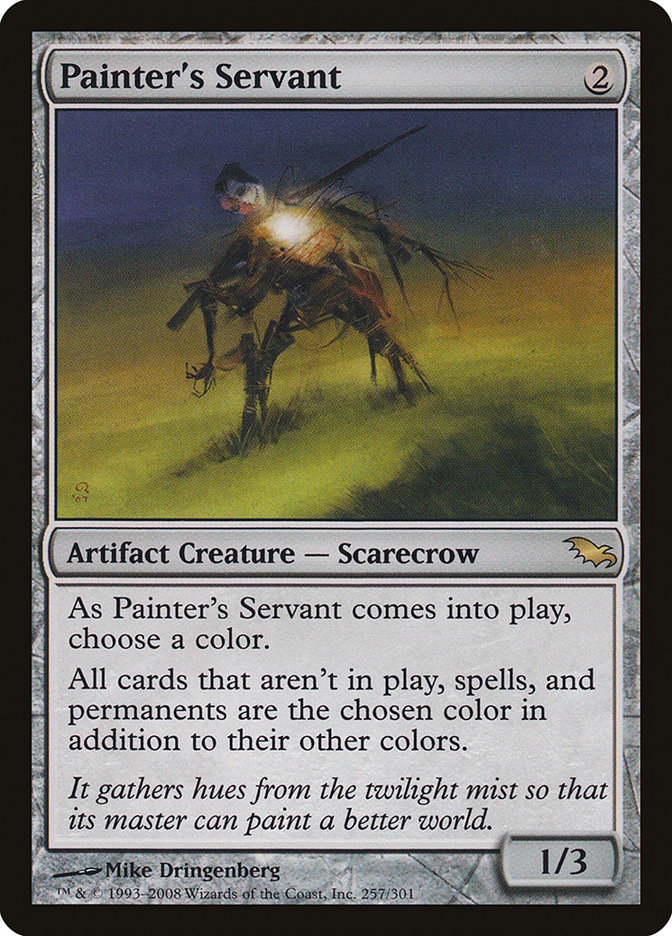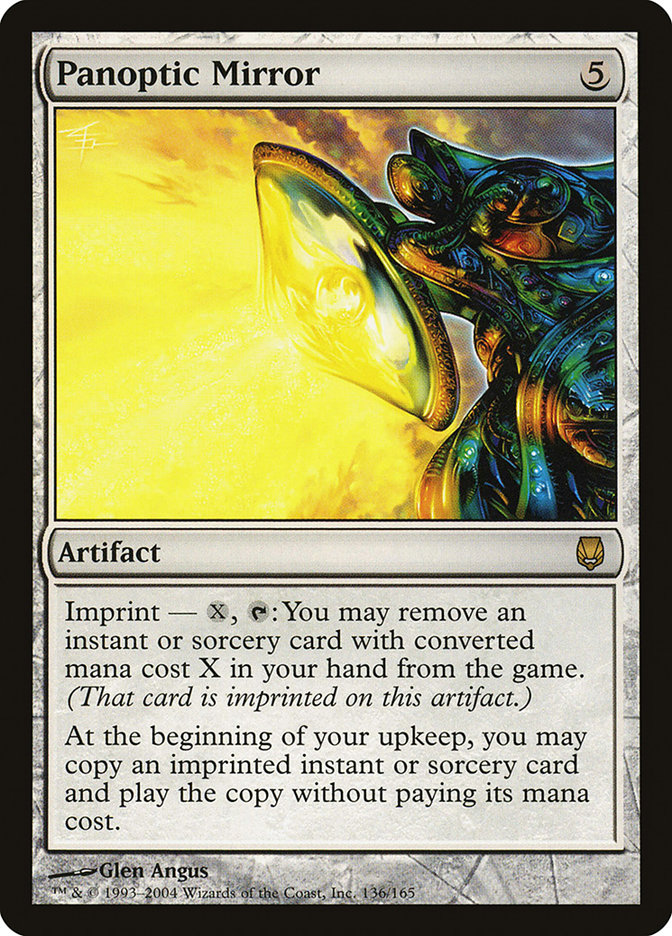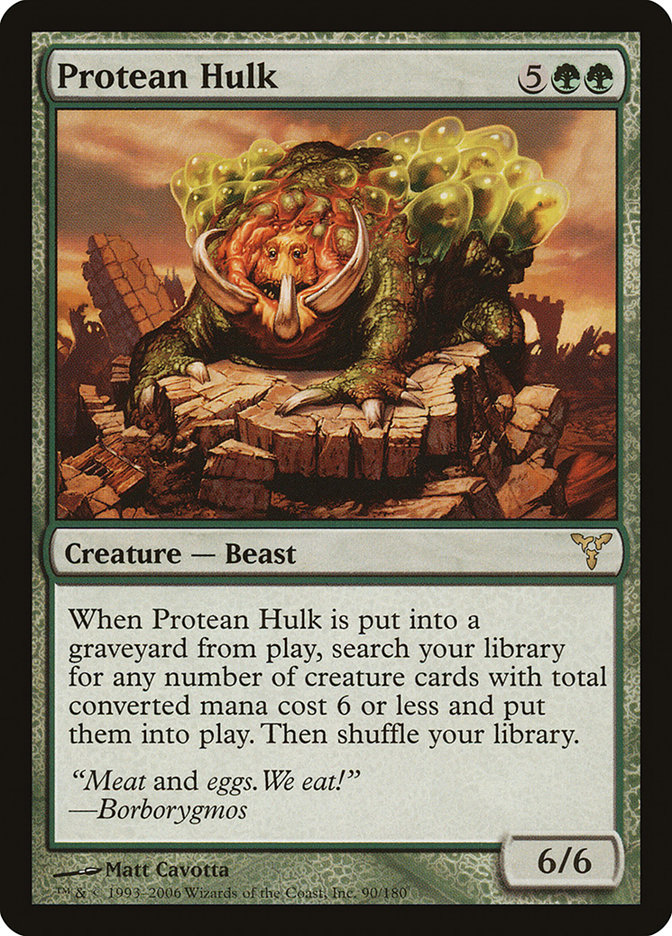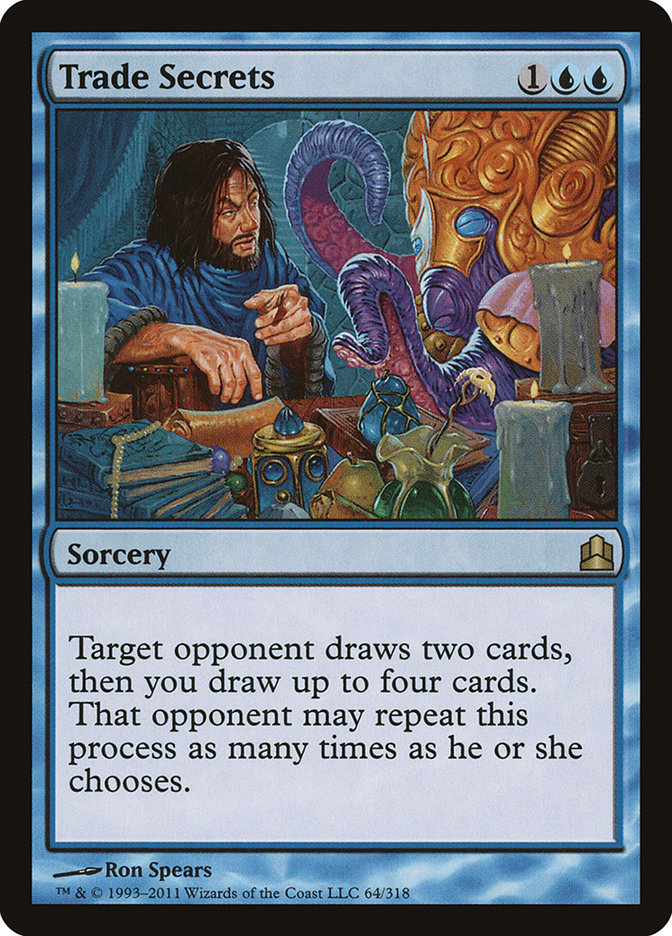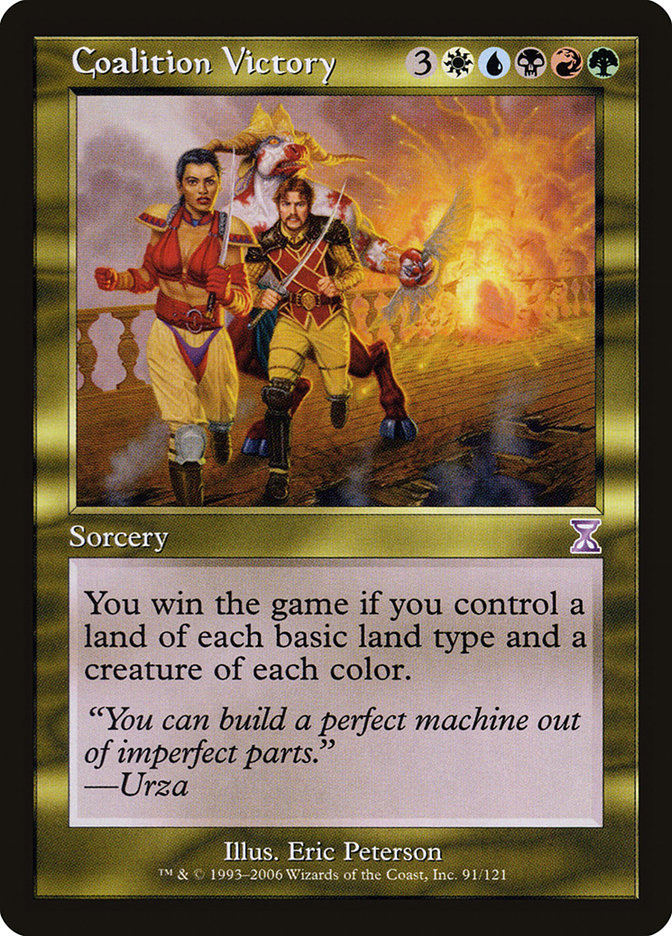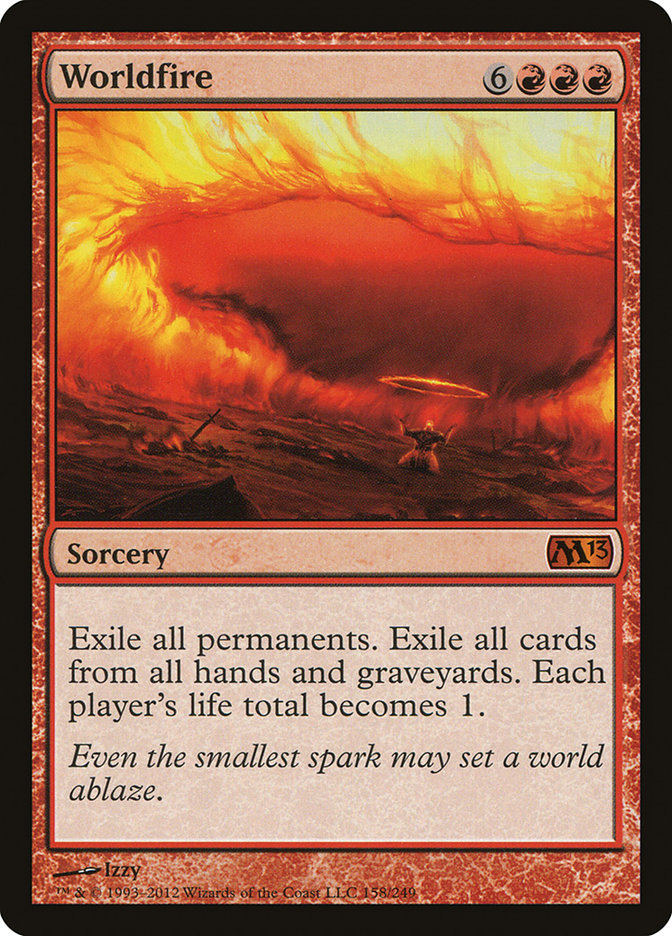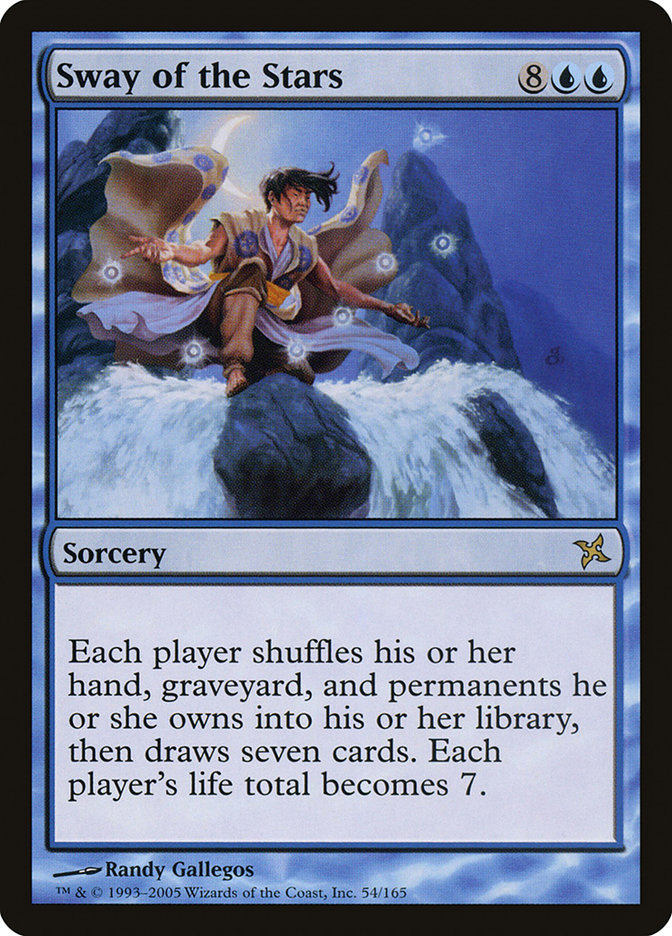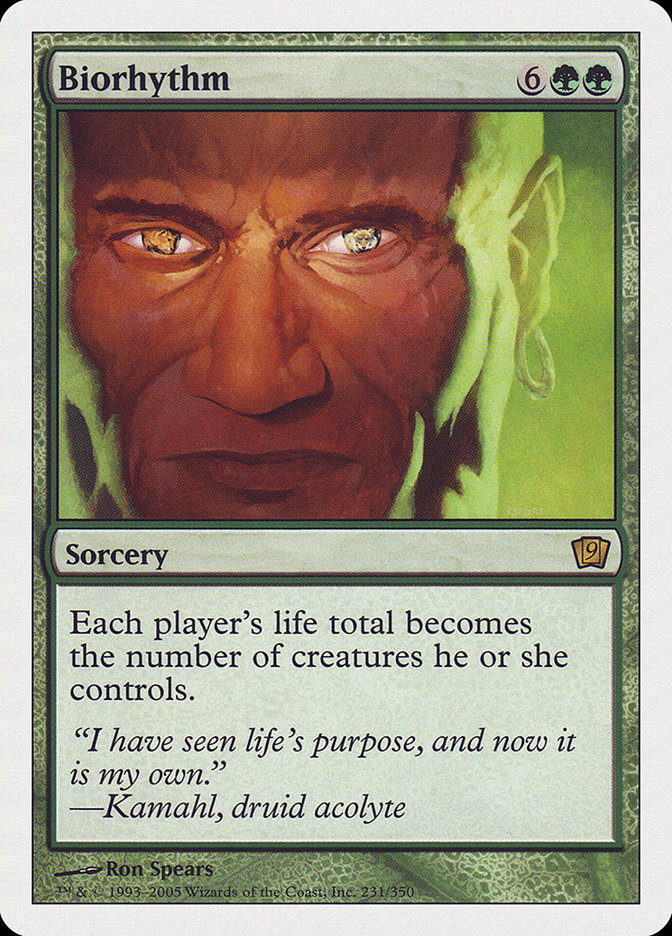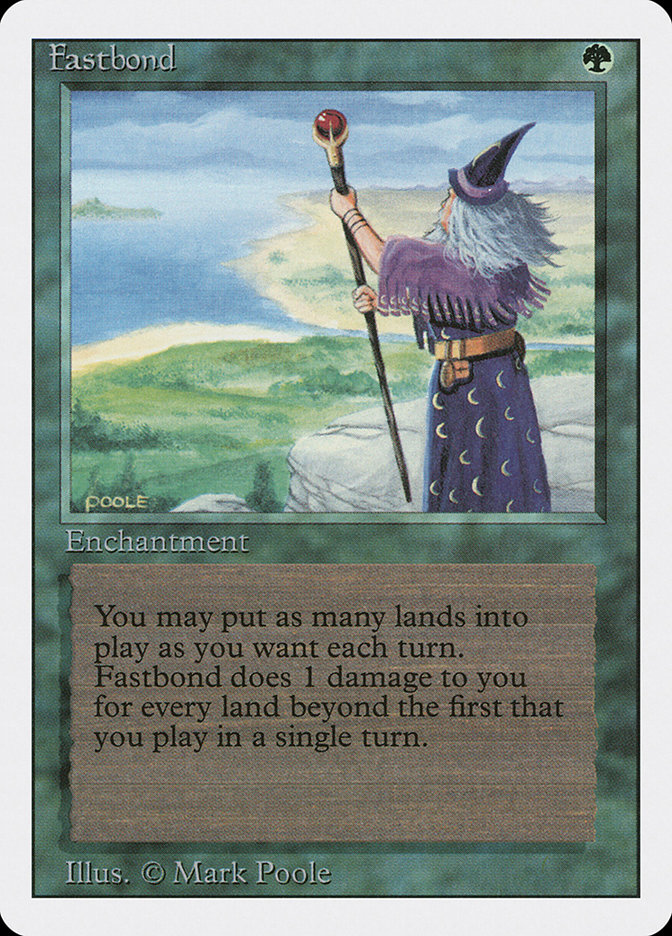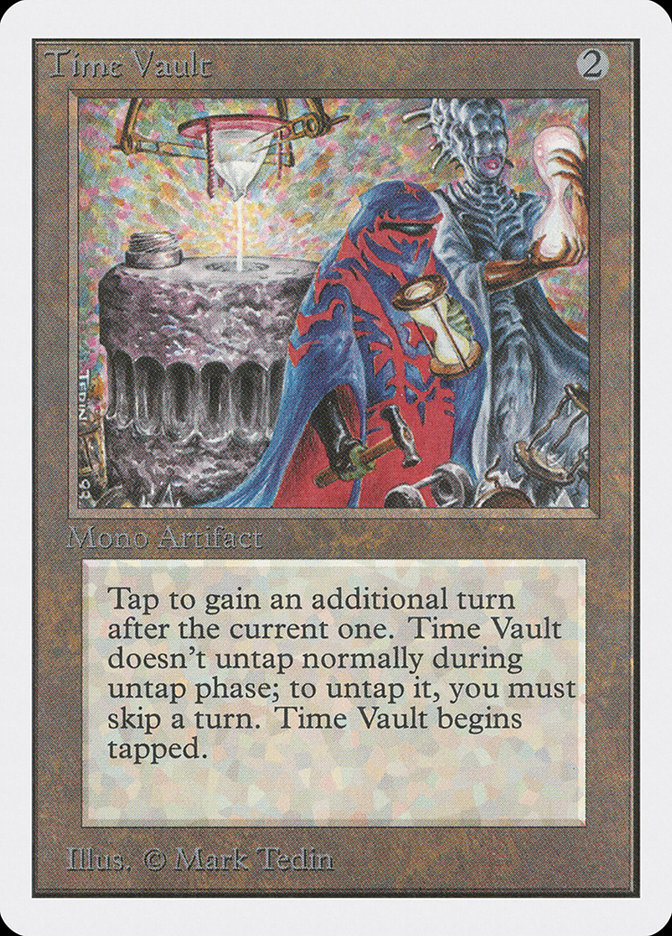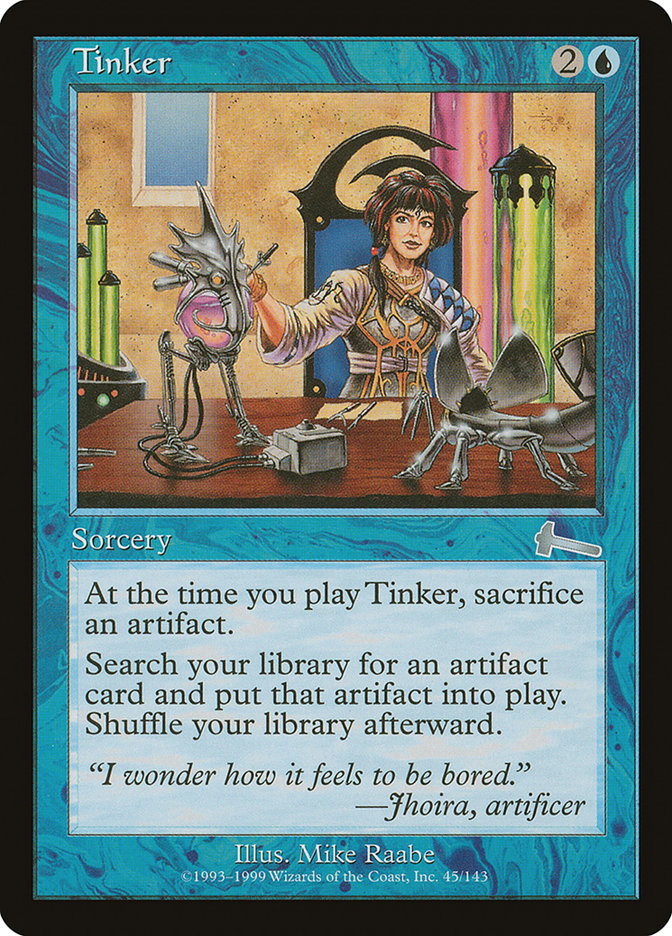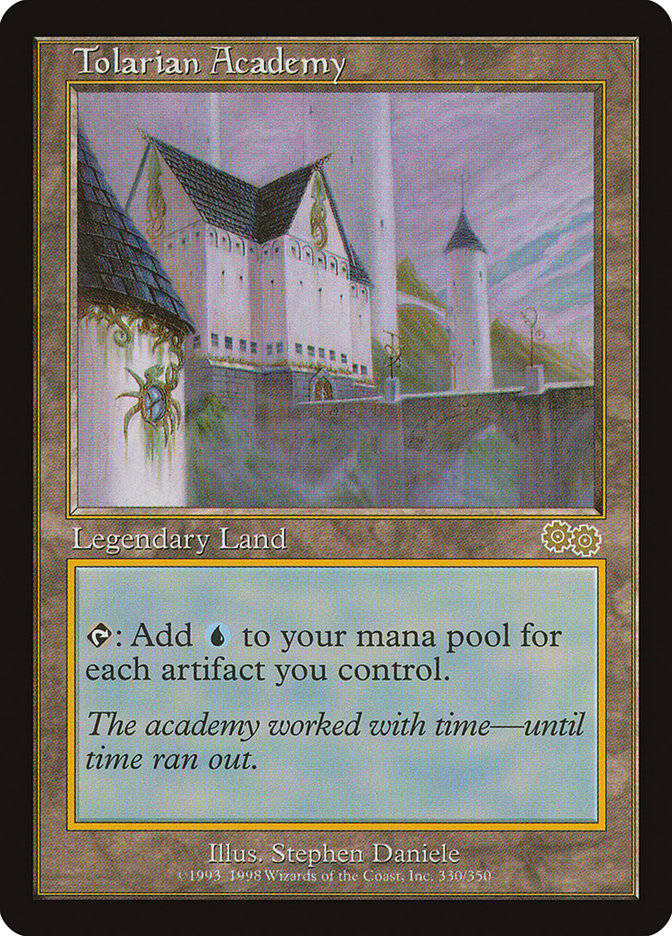Long-time readers know that I’m a fan of thought exercises, especially when it comes to keeping the Commander format on track. For example, at every meeting of the Commander Rules Committee (RC), we pick a card that’s on the banned list and argue for its removal—even if we know that it’s not likely to come off. The exercise does two things for us. One, it sharpens our skills in making an argument; if we have to make a case for something that we might not necessarily think is the right choice, we stretch our rhetorical muscles. Two, it makes sure that we’re not simply glossing over every card on the list and just assuming that since it’s banned, it should stay there. Frequently asking ourselves “Does this card still belong here?” lets both the RC and the fan base know that we’re never complacent about managing the format.
To that end, I’m going to propose a radical thought exercise: I’m going to walk you through how I would cut the banned list to ten cards if for some reason I absolutely had to—like if Elon Musk offered a pile of cash to my favorite charity or aliens came down and told me they’d solve world hunger if we could trim down the list by a significant percentage. Obviously, these are fantasies, but it’s still worth the mental energy to consider how things might happen. And you never know—the line of thought might lead somewhere.
I want to make sure everyone understands that this trip into what if isn’t a prelude to anything. There is no consideration on behalf of the committee to attempt anything of the sort. We’re pretty happy with where the banned list rests at the moment, both in what’s on it and what isn’t. Nothing out of Kaladesh gives us any heartburn so far (but if it does, we’ll let you know). This relatively safe space of being comfortable with the banned list gives me the opportunity for some exploration. Again, do not worry that one of these broken cards will suddenly show up at games in your neck of the woods.
Ten is, of course, an arbitrary number. It’s also an easy number for us to wrap our brains around when thinking of lists. It’s a number that’s sufficiently low enough to make the exercise challenging. There are currently 38 cards on the Commander Banned List, make it already one of the slimmest of all Eternal formats.
Here’s a link to the Official Banned List and Format Philosophy Document. I won’t repeat it in its entirety here, but I’ll reference it every now and again. It’s a nice review if you want to ground yourself in how and why we put cards on or take them off. The important point to remember is that there is rarely a single factor in banning cards. The intersection of multiple factors is what’s likely to get a card benched; similarly, the lack of any confluence of factors might keep a card in the game. The five basic factors are:
1. Creates Undesirable Games/Game Situations
2. Warps the Format Strategically
3. Produces Too Much Mana Too Quickly
4. Interacts Poorly with the Structure of Commander
5. Creates a Perceived Barrier to Entry
In developing the Ten Card Banned List, we’ll want to keep in mind those factors. We’ll also have to consider how our target number impacts our logic. The simple math is that since there are currently 38 cards on the list and we want to get to ten, 28 will have to be loosed in the wild. As a review, here is the current list of banned cards:
It seems like starting with the “No Way, No How” cards, those which we believe are simply toxic to the format and don’t ever want to see the light of day, is the right call. If we were doing this exercise as a committee, I might suggest that each of us pick one of the first five. As it stands, I have four: Balance, Channel, Griselbrand, and Limited Resources.
Balance: I’ve long maintained that if there were a Survivor-style banned list elimination game, Balance would be the last card standing. I’m still pretty firm that it’s at least in the last two. It certainly creates undesirable game states because of its effect-to-mana-cost ratio. At six mana, it might be perfectly safe.
Channel: Especially with the higher life total, the ability to just do whatever you want on turn 2 makes for games which it takes longer to shuffle for than to play. It isn’t always the one I think of first, but it simply can’t stay.
Griselbrand: Although there was no real need to emergency ban the card (since it was only legal for a number of weeks), everyone knows how bad Griselbrand is. It’s even stronger than Yawgmoth’s Bargain (which is certainly a consideration as an auto-keep) because it has the built-in ability to give you back all the life you’ve lost. As broken as cards get.
Limited Resources: We hate the idea of completely robbing players of the opportunity to play the game. Limited Resources does just that. This one is actually my likely first pick because it just wrecks the spirit of the multiplayer game.
With those four firmly on our list, let’s go to the other end of the spectrum and figure out what can get kicked off the raft right away. Again, we have to strategize here, since we know that we’re heading for a finite number. We’re not actually making the optimal banned list; we’re making the best list we can given the restrictions we’re under. Don’t take any arguments for taking off cards for our ten-card list as arguments for taking them off a more open list.
Knowing that we have to get down to ten and that we can’t keep all the cards that fall under Perceived Barrier to Entry, those iconic cards get out of jail. Ancestral Recall, Black Lotus, Library of Alexandria, Mox Emerald, Mox Jet, Mox Pearl, Mox Ruby, Mox Sapphire, and Time Walk become free (although I might keep the handcuffs on Time Walk for an extra minute; it’s one we could call back).
Another potentially easy category to look at are the former Banned As Commander cards. You might think it’s cheaty, but bringing back the category would free up three slots, as Braids, Cabal Minon; Erayo, Soratami Ascendant; and Rofellos, Llanowar Emissary would be available as one of your 99. As part of the deck, the first two seem okay-ish; having Rofellos running around again seems less desirable, if only because green really doesn’t need any more help exploding into mana.
Cards which are on the borderline form the next group for removal. These are the ones people talk about most and there is a reasonable amount of support for unbanning them already. I put Gifts Ungiven, Painter’s Servant, Panoptic Mirror, Protean Hulk, Recurring Nightmare, and Trade Secrets in this particular category.
Gifts Ungiven: It’s an easy combo-enabler, mostly because it’s an instant. With our ten-card list, we’d likely live in a world with more combo in it, but that would simply be part of the adjustment period.
Painter’s Servant: The folks who support its removal right now say that there are worse enablers; the primary fear is color-hosing and in combination in particular with Iona, Shield of Emeria. Matching it up with Grindstone only knocks out one player at time, so the argument is that it’s no worse than Leyline of the Void and Helm of Obedience. The upside here is that there are probably lots of cool things to do with the card to nearly balance out the bad stuff it brings.
Panoptic Mirror: With time magic, it becomes an oppressive card. I suppose that there are other “I win” cards (like Felidar Sovereign) which opponents have a turn cycle to do something about, so we’d have to think of Panoptic Mirror in that light. Who knows? Maybe someone would think of cool uses that didn’t involve extra turns or endless Wraths.
Protean Hulk: We’ve done some local testing with Protean Hulk to mixed results. The first one, three or four years ago, led to an “OMG, keep it banned” response. More recently, results were a little more mixed—although it must be said that it was in a narrower context. The recent results also likely highlight the fact that good graveyard hate has become more available over the intervening years.
Recurring Nightmare: The pet card of at least two of the five RC members, setting Recurring Nightmare free in this dream world make sense. As I mention with Protean Hulk, we might be in a period where there are so many good, playable ways of dealing with graveyards that the card might not be as problematic as it once was.
Trade Secrets: We don’t like what happens when Trade Secrets get played, since two players simply collude to work out the rest of the game. There’s something to be said for multiplayer politics, but Trade Secrets is an egregious sin. The saving grace is that it probably wouldn’t get played that much anyway, so we could give it some leeway.
Although it doesn’t really go with these cards, I’ll add Coalition Victory to this part of the list. Sure, it’s a deflating game-ender, but the uses of it are narrow enough (only in five-color decks, for one) that it might be safe out in the wild.
Now things start to get truly difficult. We’re left with fifteen cards, only six of which can go on the list. Still left are:
I was going to start with chopping the easiest of them, but not one of them is easy. I think we have to decide at this point that Karakas interacts so poorly with the format that it must stay banned. The ability to shut down the primary calling card of the format (commanders) without any thought or strategizing (compared to something like Nevermore, which you get locked into) just makes it undesirable. Our list is now five cards, which means that there are still eight to let go.
My first “easy” cut is Worldfire. Don’t get me wrong—it interacts horribly with the format. I’m looking at it in light of how much it would actually get played. It costs nine mana. It’s a game-ender, but one of the things about our ten-card list is that we’re going to have to get used to single-card game-winners. At least it’s in red, which can use all the help it can get.
I’m not a fan of cascading bans (it’s a path to madness and a 200-card banned list), but in this case, I think we have to use it on Sway of the Stars. If nine-mana Worldfire is okay, then ten-mana Sway of the Stars isn’t so awful. You might think that Upheaval follows on directly from Sway of the Stars, but let’s hang onto that one for a moment.
If we’re going down this road, then Biorhythm gets out of the cage. None of us are fans of drawing games or easy wins, but the good news is that we’re using the cascade idea under a closed umbrella. This is the point at which it ends.
Fastbond is probably next. It’s on the regular list because it creates too much mana too quickly. The reason we can cut it here is because it does so under limited circumstances (unlike Channel, which is bad nearly all the time). You actually have to have the lands in your hand to get some benefit from Fastbond, although once you add Horn of Greed, things get a little stickier. Still, in the Wild West world we’re creating, it seems like one of the least offensive.
Time Vault goes free because it’s a little more difficult to come by and at least you have to go through some gyrations in order to get it working. I suppose it’s a pretty cheap combo with Voltaic Key. I’d hope that the social contract does some work in this case. Both the players playing the combo (which is easy to tutor for also) and their local groups would get tired of it quickly enough that it would go out of favor pretty quickly.
We’re getting down to the worst of the worst here. Nine cards for the final five slots. At this point, it’s worth looking at things a little more holistically. What kind of environment have our cuts created? We’re going to have some high-mana cards ending games, but that’s not the worst thing. I’d prefer that to games ending on turn 3. If we can avoid the early-turn wins, what do we want our mid-turn games to look like? More to the point, which cards are the worst for the games which we’d like to promote?
The first answer I get here is that Tinker is surprisingly safe (and trust me, I don’t think I’d ever hear myself saying anything remotely close to that). Sure, it’s going to lead to the occasional turn 3 Blightsteel Colossus, but that’s not always an auto-win. It’s enough to be irritating, but not so much as to further damage our already-damaged environment, since it’s a one-shot.
That same logic keeps Tolarian Academy on the banned list. It’s not a one-shot, it’s more of the same every turn. It just can’t be let loose.
The second answer here regards the cards in the five-to-seven-mana slots, which give us the worst games in our blight-scape. Prophet of Kruphix, Primeval Titan, and Sylvan Primordial ruin the kinds of games we have left (or at least the kind we’d like to save). They have to stay in irons.
We’ve come down to only one remaining spot for either Emrakul, Sundering Titan, Upheaval, or Yawgmoth’s Bargain. Talk about your no-win situations. So which is the worst of the worst? There aren’t positive arguments to be made for any of them. I think here it has to be Yawgmoth’s Bargain. The ability to exchange life for cards which you get immediately (unlike Necropotence) is just too much for us. Upheaval at least needs a bigger-picture plan to get advantage out of (just The Great Aurora). It’s weird to say, but Sundering Titan and Emrakul are simply the lesser offenders here.
To wrap it up, here’s what the Ten Card Banned List looks like:
I hope that this exercise demonstrates how difficult choices get made as well as revealing how dangerous the cards on the banned list can be to the health of the format. We put a good deal of thought into the list from the top down, not just one card at a time. This kind of process has led the format to being reasonably healthy, and we want it to stay that way. Fortunately, as this was just a stretch exercise, you can rest assured that none of these baddies will show up at tables near you anytime soon—with very good reason.
This Week’s Deck Without Comment is Ruhan Do Over.
Creatures (28)
- 1 Weathered Wayfarer
- 1 Karmic Guide
- 1 Boldwyr Intimidator
- 1 Balefire Liege
- 1 Knight of the White Orchid
- 1 Knight-Captain of Eos
- 1 Kederekt Leviathan
- 1 Serra Ascendant
- 1 Sunblast Angel
- 1 Hero of Bladehold
- 1 Hero of Oxid Ridge
- 1 Suture Priest
- 1 Hellrider
- 1 Odric, Master Tactician
- 1 Aurelia, the Warleader
- 1 Firemane Avenger
- 1 Frontline Medic
- 1 Legion Loyalist
- 1 Tajic, Blade of the Legion
- 1 Purphoros, God of the Forge
- 1 Medomai the Ageless
- 1 Felhide Spiritbinder
- 1 Sphinx's Disciple
- 1 Iroas, God of Victory
- 1 Keranos, God of Storms
- 1 Thousand Winds
- 1 Hallowed Spiritkeeper
- 1 Arashin Foremost
Planeswalkers (4)
Lands (37)
Spells (30)
- 1 Sol Ring
- 1 Fellwar Stone
- 1 Goblin Bombardment
- 1 Kirtar's Wrath
- 1 Decree of Justice
- 1 Skullclamp
- 1 Opposition
- 1 Wayfarer's Bauble
- 1 Coastal Piracy
- 1 Mind Stone
- 1 Field of Souls
- 1 Dismantling Blow
- 1 Ghostway
- 1 Prismatic Lens
- 1 Pollen Lullaby
- 1 Springleaf Drum
- 1 Goblin Assault
- 1 Armillary Sphere
- 1 Elixir of Immortality
- 1 True Conviction
- 1 Phyrexian Rebirth
- 1 Increasing Devotion
- 1 Blustersquall
- 1 Vandalblast
- 1 Assemble the Legion
- 1 Azorius Cluestone
- 1 Boros Cluestone
- 1 Spirit Bonds
- 1 Make a Stand
- 1 Pore Over the Pages

Check out our comprehensive Deck List Database for lists of all my decks:
SIGNATURE DECKS
Purple Hippos and Maro Sorcerers; Kresh Into the Red Zone; Halloween with Karador; Dreaming of Intet; You Did This to Yourself;
THE CHROMATIC PROJECT
Mono-Color
Heliod, God of Enchantments; Thassa, God of Merfolk; Erebos and the Halls Of The Dead; Forge of Purphoros; Nylea of the Woodland Realm; Karn, Beatdown Golem
Guilds
Lavinia Blinks; Obzedat, Ghost Killer; Aurelia Goes to War; Trostani and Her Angels; Lazav, Shapeshifting Mastermind; Zegana and a Dice Bag; Rakdos Reimagined; Glissa, Glissa; Ruric Thar and His Beastly Fight Club; You Take the Crown, I’ll Take Leovold; Gisa and Geralf Together Forever;
Shards and Wedges
Adun’s Toolbox; Animar’s Swarm; Karrthus, Who Rains Fire From The Sky; Demons of Kaalia; Merieke’s Esper Dragons; Nath of the Value Leaf; Rith’s Tokens; The Mill-Meoplasm; The Altar of Thraximundar; The Threat of Yasova; Zombies of Tresserhorn
Five-Color
THE DO-OVER PROJECT
Animar Do-Over; Karador Do-Over; Karador Version 3; Karrthus Do-Over; Mimeoplasm Do-Over; Phelddagrif Do-Over; Rith Do-Over; Ruhan Do-Over
If you’d like to follow the adventures of my Monday Night RPG group (in a campaign that’s been alive since 1987) which is just beginning the saga The Lost Cities of Nevinor, ask for an invitation to the Facebook group “Sheldon Menery’s Monday Night Gamers.”



